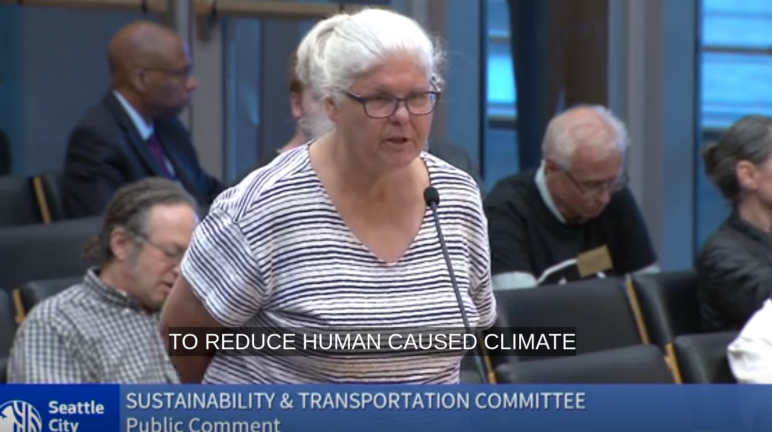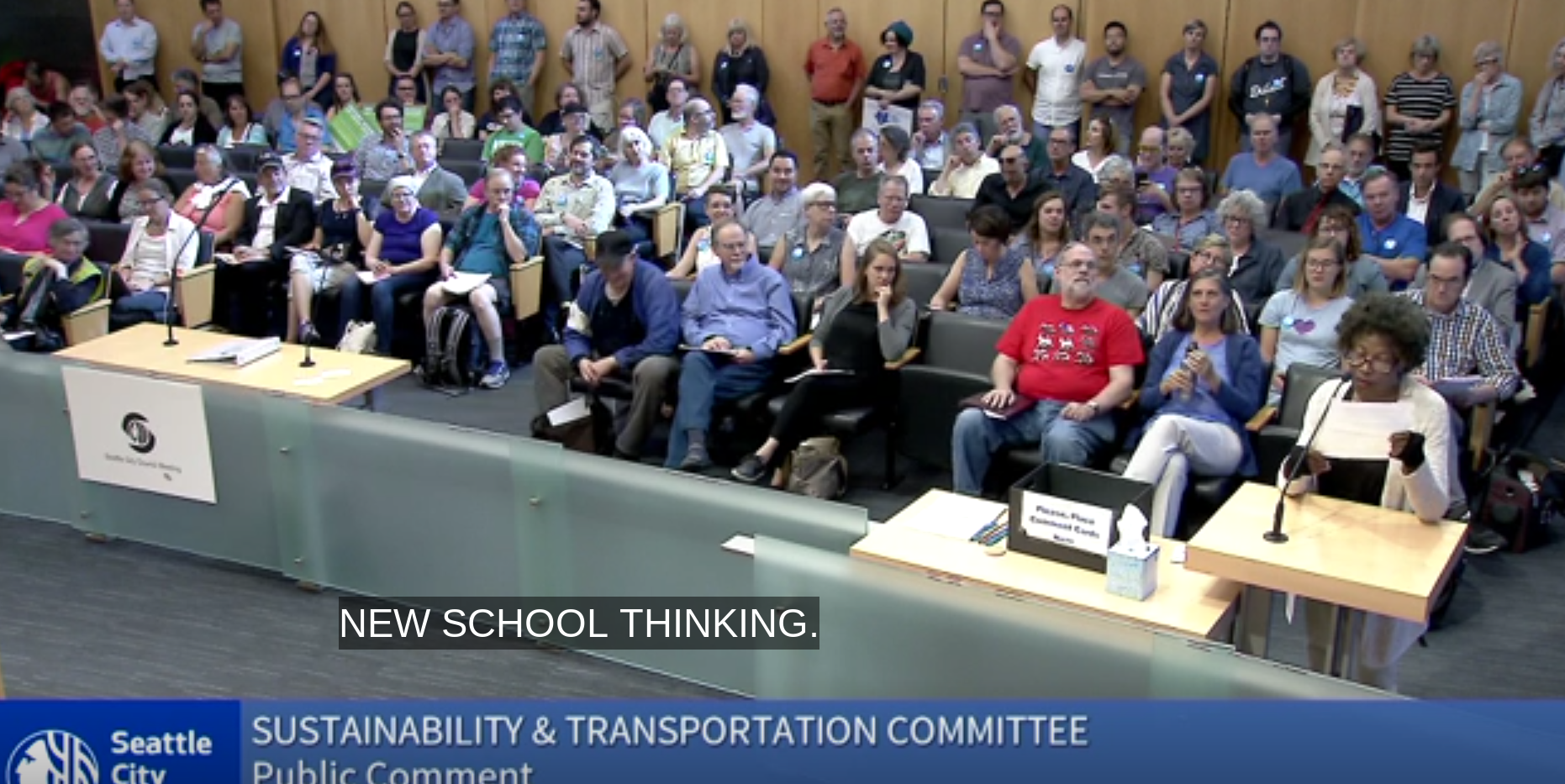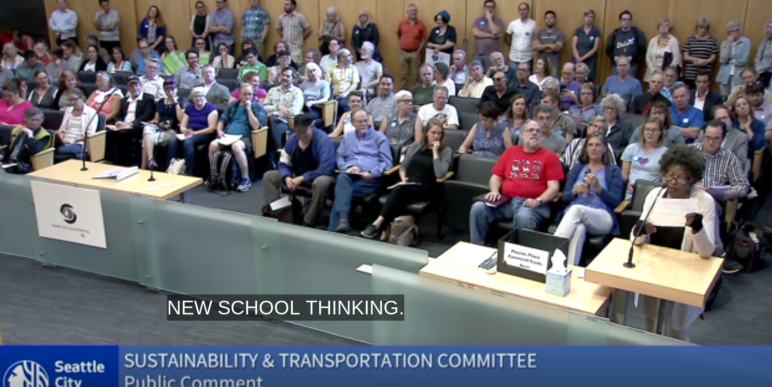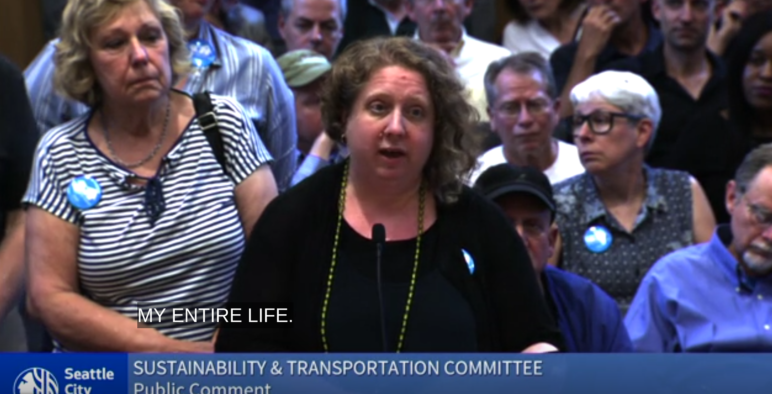How do you say, again, something that ought to be obvious: That if people want to, they should be allowed to build little homes in the backyards of a beautiful city?
After four years of navigating seemingly endless legal appeals from a handful of anti-housing homeowners, Seattle’s housing advocates showed up again this month to say as loudly as ever that secondary cottages should be legal in more situations, not fewer, than new single-detached oneplexes.
“It’s classist to say a developer could build a McMansion in the city somewhere but they can’t build three smaller homes for three families to live in,” Seattleite Rachael Ludwick, wearing a “Green New Deal” shirt, told the city’s Sustainability & Transportation Committee before its vote to send the housing reform to city council last week.
Ludwick spoke against an amendment, ultimately rejected by the committee, designed to prevent two accessory dwelling units (ADUs) from being added to a lot simultaneously.
Also testifying: Ludwick’s mom, Jeannine Shingler, who recently moved from Vancouver, Washington, to a cottage in Ludwick’s yard.
“I am able to live in Seattle because I live in an ADU,” Shingler said. “I gave up my car after 50 years of driving and I love that.”

“This is too important to sit back and say we shoulda woulda coulda,” said Seattle ADU resident Jeannine Shingler. “Be too late then.”
At the committee’s June 11 hearing, pro-housing group MOAR Seattle tallied 61 testifiers in favor of fully lifting the city’s existing ban on double ADUs. That was more than three-quarters of those who spoke.
“If we don’t do this, that’s 2,000 families that won’t have housing in our city,” said Laura Loe, speaking for MOAR and the coalition Share The Cities. She urged the city to pass Councilmember Mike O’Brien’s plan with as few amendments as possible. “And for those 2,000 families, that’s a big deal, even though it’s a drop in the bucket of what we need.”
It won’t be the last time this summer that a broad spectrum of Seattle civic activists—from 350 Seattle to the Seattle Renters Commission, Sierra Club, Tech4Housing, Central District Anti-Displacement Project, Washington Physicians for Social Responsibility, Real Change News, and others—will need to make a public case for housing and climate action. A full council vote is set for July 1 and it’s still unclear which restrictions on new secondary cottages might be reintroduced.
But each of the last two weeks, one Seattleite after another stood to make the case for clean legalization of two secondary cottages per lot—one attached, one detached—and a new cap on building size intended to redirect the city’s construction market away from huge luxury homes and toward less expensive, less polluting clusters of smaller ones.
Many testimonials shared a theme: Cottages are an especially useful housing option for multigenerational families. One of the most compelling comments came from Ellen Milne, a Capitol Hill tenant who arrived at City Hall with her parents, Gary and Janice:
I called Seattle home since 1997 and I rent on Capitol Hill so I could live car-free and walk or use transit to work, shop and live. It’s why I chose my neighborhood over 20 years ago and why I want my parents to join me in Seattle. Ten years ago, my parents downsized. They sold their house in Maple Valley that they retired to and spent the next decade traveling in an RV. …
But my father turns 78 this year, and my mother 74. Both drive less but use transit regularly, and in the last year we’ve been having tough conversations about next steps for their future. But while my brother and I both rent in central Seattle, neither of us are in buildings appropriate for our families to live with us.
They want to remain independent for as long as they can. They’re in good health. They’re physically active. They’re not candidates for assisted living. And after living in an RV for the next decade, their space needs are modest. A backyard cottage somewhere like Queen Anne or Capitol Hill would be perfect. A walkable neighborhood near libraries, grocery stores and a church community, with easy bus connections to their doctors on First and Cherry Hill. But under the current restrictions on ADUs there simply aren’t enough cottages for them to rent. I want to be there to help my parents when they need me. To make that happen, we need more rental options in all our neighborhoods. Reducing the barriers to the creation of ADUs will help make that a reality.
Please pass this common-sense reform and help our city and my family. My parents want to be your neighbors.
Seattle’s ADU reform has taken years of work to advance. The bright side is that all the struggle has given Seattle hundreds of ordinary activists like Milne and her parents, willing to stand up and repeat an obvious, necessary truth: It’s good when cities make it legal for its residents to live with the people they want, in the places they want.
This idea shouldn’t be controversial. If ordinary people take the time to say it often enough, maybe it won’t be.
Thanks to Sightline Communications Associate Kelsey Hamlin for contributing to this article and to all those who showed up recently and in the past to testify on housing.











Russell
Is independent legislation now proposed to splinter off 2-ADUs from the broader policy set? If so, why are we splintering it and does that diminish the chances of the broader legislation will pass?
Michael Andersen
I don’t follow. Which broader policy set?
David Moehring
There’s really nothing in this article of relevence. Every point quoted in already possible with 85-percent of the lots in Seattle. The appeal of QACC did not object to reasonable changes in the Accessible Dwelling Unit Code. Read the appeal and TreePAC intervention online.
Hearing Examiner decision expected around May 17, 2019.
See the full public record listing at https://web6.seattle.gov/Examiner/case/W-18-009
Info from QACC on this appeal – Go to https://queenanneappeal.org/
https://outsidecityhall.wordpress.com/2019/06/05/june-11th-tues-530pm-city-council-public-hearing-on-cm-obriens-adu-dadu-legislation/
Michael Andersen
The hearing examiner decision was indeed delivered last month…? Did this comment arrive via time machine?